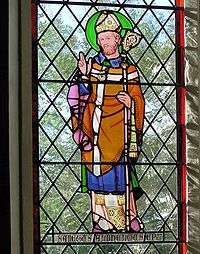Aldhelm
| Aldhelm | |
|---|---|
| Bishop of Sherborne | |
|
Stained glass window showing Aldhelm, installed in Malmesbury Abbey in 1938 | |
| Diocese | Sherborne |
| Successor | Forthhere |
| Other posts | Abbot of Malmesbury |
| Personal details | |
| Born |
c. 639 Wessex |
| Died |
25 May 709 Doulting, Somerset |
| Sainthood | |
| Feast day | 25 May |
| Venerated in |
Eastern Orthodox Church Roman Catholic Church Anglican Communion |
| Attributes | monk playing a harp; or bishop with staff sprouting ash leaves |
| Patronage | Malmesbury; Sherborne; musicians; song writers |
| Shrines | Malmesbury Abbey, now destroyed. |
Aldhelm (Old English: Ealdhelm, Latin: Aldhelmus) (c. 639 – 25 May 709), Abbot of Malmesbury Abbey, Bishop of Sherborne, Latin poet and scholar of Anglo-Saxon literature, was born before the middle of the 7th century. He is said to have been the son of Kenten, who was of the royal house of Wessex.[1] He was certainly not, as his early biographer Faritius asserts, the brother of King Ine. After his death he was venerated as a saint, his feast day being the day of his death, 25 May.
Life
Early life and education
Aldhelm received his first education in the school of an Irish scholar and monk, Máeldub (also Maildubh, Maildulf or Meldun) (died c. 675),[2] who had settled in the British stronghold of Bladon (or Bladow) on the site of the town called Mailduberi, Maldubesburg, Meldunesburg, etc., and finally Malmesbury, after him.
In 668, Pope Vitalian sent Theodore of Tarsus to be Archbishop of Canterbury. At the same time the North African scholar Hadrian became abbot of St Augustine's at Canterbury. Aldhelm was one of his disciples,[1] for he addresses him as the 'venerable preceptor of my rude childhood.' He must, nevertheless, have been thirty years of age when he began to study with Hadrian. His studies included Roman law, astronomy, astrology, the art of reckoning and the difficulties of the calendar. He learned, according to the doubtful statements of the early lives, both Greek and Hebrew. He certainly introduces many Latinized Greek words into his works.
Ill health compelled him to leave Canterbury, and he returned to Malmesbury Abbey, where he was a monk under Máeldub for fourteen years, dating probably from 661, and including the period of his studies with Hadrian.
Abbot of Malmesbury
When Máeldub died, Aldhelm was appointed in 675,[1] according to a charter of doubtful authenticity cited by William of Malmesbury, by Leuthere, Bishop of Winchester (671–676), to succeed to the direction of the monastery, of which he became the first abbot.[2]
Aldhelm introduced the Benedictine rule, and secured the right of the election of the abbot to the monks themselves. The community at Malmesbury increased, and Aldhelm was able to found two other monasteries as centres of learning, at Frome, Somerset and at Bradford on Avon, Wiltshire. The little church of St Lawrence at Bradford on Avon dates back to his time, and may safely be regarded as his. At Malmesbury he built a new church to replace Máeldub's modest building,[2] and obtained considerable grants of land for the monastery.
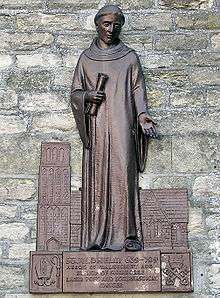
Contemporary reputation
His fame as a scholar spread to other countries. Artwil, the son of an Irish king, submitted his writings for Aldhelm's approval, and Cellanus, an Irish monk from Peronne, was one of his correspondents. Aldhelm was the first Anglo-Saxon, so far as we know, to write in Latin verse, and his letter to Acircius (Aldfrith or Eadfrith, king of Northumbria) is a treatise on Latin prosody for the use of his countrymen. In this work he included his most famous productions, 101 riddles in Latin hexameters. Each of them is a complete picture, and one of them runs to 83 lines.
That his merits as a scholar were early recognised in his own country is shown by the encomium of Bede (Historia ecclesiastica gentis Anglorum 5.18), who speaks of him as a wonder of erudition. His fame reached Italy, and at the request of Pope Sergius I he paid a visit to Rome, of which, however, there is no notice in his extant writings. On his return, bringing with him privileges for his monastery and a magnificent altar, he received a popular ovation.
Easter controversy
He was deputed by a synod of the church in Wessex to remonstrate with the Britons of Dumnonia (Devon and Cornwall) on the Easter controversy. British Christians followed a unique system of calculation for the date of Easter and also bore a distinctive tonsure; these customs are generally associated with the practice known as Celtic Christianity. Aldhelm wrote a long and rather acrimonious letter to king Geraint of Dumnonia (Geruntius) achieving ultimate agreement with Rome.
Bishop of Sherborne
In 705, or perhaps earlier, Hædde, Bishop of Winchester, died, and the diocese was divided into two parts.[3] Sherborne was the new see, of which Aldhelm became the first bishop around 705.[4] He wished to resign the abbey of Malmesbury which he had governed for thirty years, but yielding to the remonstrances of the monks he continued to direct it until his death. He was now an old man, but he showed great activity in his new functions. The cathedral church which he built at Sherborne, though replaced later by a Norman church, is described by William of Malmesbury. In his capacity as bishop, he displayed a great deal of energy. This included going into public places where he would sing hymns and passages from the gospels interspersed with bits of clowning to draw attention to his message.
Death and veneration
Aldhelm was on his rounds in his diocese[5] when he died at the church of Doulting in 709.[4] The body was taken to Malmesbury, and crosses were set up by his friend, Egwin, Bishop of Worcester, at the various stopping-places.[6] He was buried in the church of St Michael at Malmesbury Abbey.[7] His biographers relate miracles due to his sanctity worked during his lifetime and at his shrine. The cape in Dorset commonly known as St Alban's Head is more properly called St. Aldhelm's Head in his honour.
He was revered as a saint after his death, with his feast day being celebrated on 25 May.[1] His relics were translated in 980 by Dunstan, the Archbishop of Canterbury.[7] He is commemorated by a statue in niche 124 of the West Front of Salisbury Cathedral.
St. Aldhelm's flag may be flown in his celebration. The flag, a white cross on a red background, is a colour reversed version of Englands St. George flag.[8][9]
Churches
-

Sandelheath
-
Belchalwell
-
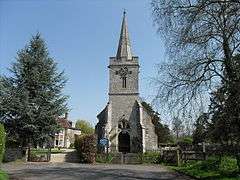
-
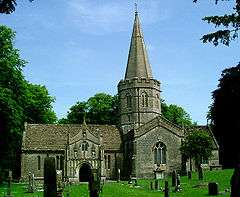
Doulting
-

Chessels
-

Branksome
-

Lytchett Heath
-
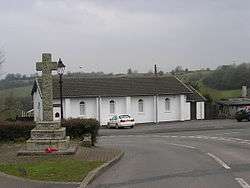
Chilcompton
-

Bristol
Writings
Aldhelm wrote in elaborate, grandiloquent and very difficult Latin, known as hermeneutic style. This verborum garrulitas shows the influence of Irish models and became England's dominant Latin style for centuries,[10] though eventually it came to be regarded as barbarous. His works became standard school texts in monastic schools, until his influence declined around the time of the Norman Conquest.
Aldhelm's collected works were edited by Rudolf Ehwald, Aldhelmi opera (Berlin, 1919). An earlier edition by J. A. Giles, Patres eccl. Angl. (Oxford, 1844) was reprinted by JP Migne in his Patrologiae Cursus, vol. 89 (1850).
Prose
- De Laude Virginitatis (the prose De Virginitate), a Latin treatise on virginity addressed to the nuns of the double monastery at Barking, is Aldhelm's best-known work. After a long preface extolling the merits of virginity, he commemorates a great number of male and female saints. Aldhelm later wrote a shorter, poetic version (see below).
- Epistola ad Acircium (sive Liber de septenario, et de metris, aenigmatibus ac pedum regulis), dedicated to one Acircius, understood to be King Aldfrith of Northumbria (r. 685-704/5). The chief source of his Epistola ad Acircium (ed. A. Mai, Class. Auct. vol. V) is Priscian. The acrostic introduction gives the sentence, 'Aldhelmus cecinit millenis versibus odas,' whether read from the initial or final letters of the lines. After an address to King Aldfrith, the letter consists of three treatises:
- De septenario, treatise on the number seven in arithmology
- De metris, treatise on metre, including the Enigmata (see below).
- De pedum regulis, didactive treatise on metrical feet, such as iambs and spondees.
- Other Letters. Correspondents include Bishop Leuthere, Hadrian, King Geraint of Dumnonia, Eahfrid, Cellanus, Sergius and Aldhelm's pupils Wihtfrith and Æthelwald, who was responsible for part of the Carmen rhythmicum.[11]
- The letter to King Geraint of Dumnonia, was supposed to have been destroyed by the Britons (William of Malmesbury, Gesta pontificum Anglorum p. 361), but was discovered with others of Aldhelm's in the correspondence of St Boniface, archbishop of Mainz.
- A long letter to Eahfrid, a scholar just returned from Ireland (first printed in Usher, Veterum Epistt. Hiber. Sylloge, 1632), is of interest as casting light on the relations between English and Irish scholars.
Poetry
- Carmen de virginitate (the poetic De Virginitate). Aldhelm wrote a shorter, poetic version of De Laude Virginitatis, which closes with a battle of the virtues against the vices, the De octo principalibus vitiis (first printed by Delrio, Mainz, 1601). The two works are what is sometimes called an opus geminatum or "twin work".
- Carmen rhythmicum, rhythmic poem which describes a travel through western England and the way a wooden church was affected by a storm.
- Carmina ecclesiastica (modern title), i.e. a number of Latin tituli designed for inscription on a church or altar. They are: (1) In Basilica Sanctorum Petri et Pauli, for a church dedicated to St Peter and St Paul, possibly the church which Aldhem founded at Malmesbury, (2) In Basilica Beatae Mariae Semper Virginis, St Mary's Church, possibly also at Malmesbury, (3) In Ecclesia Mariae a Bugge Extructa, for the church built by Bugga, that is Eadburh of Minster-in-Thanet, a royal lady of the house of Wessex, (4) the twelve tituli known collectively as In Duodecim Apostolorum Aris and (5) In sancti Matthiae Apostoli Ecclesia.
- Enigmata, 100 (hexa)metrical riddles, included in the Epistola ad Acircium for purposes of illustration (see above); among the more famous is the riddle entitled Lorica. For these riddles, Aldhelm's model was the collection known as Symposii Aenigmata ("The Riddles of Symphosius"). Aldhelm based many of his riddles on The Hundred Riddles of Symphosius. But not "Creatura", the 100th riddle. Its source is the Corpus Hermeticum, Treatise XI, 20, where the Divine Intellect, the Mind of God is addressing Hermes Trismegistus. Aldhelm may have known the passage through his teacher Hadrian.
Lost works
According to William of Malmesbury, Aldhelm also wrote poetry in Old English, and set his own compositions to music, but none of his songs, which were still popular in the time of Alfred, have come down to us. Finding his people slow to come to church, he is said to have stood at the end of a bridge singing songs in the vernacular, thus collecting a crowd to listen to exhortations on sacred subjects.[12]
See also
Notes
- 1 2 3 4 Walsh A New Dictionary of Saints p. 21-22
- 1 2 3 "St. Aldhelm (c. 639–709)", Athelstan Museum, Malmesbury
- ↑ "Sherborne Town". Sherborne Town. Retrieved 17 August 2013.
- 1 2 Fryde, et al. Handbook of British Chronology p. 222
- ↑
 Chisholm, Hugh, ed. (1911). "Aldhelm". Encyclopædia Britannica (11th ed.). Cambridge University Press.
Chisholm, Hugh, ed. (1911). "Aldhelm". Encyclopædia Britannica (11th ed.). Cambridge University Press. - ↑ Thurston, Herbert (1907). St. Aldhelm. The Catholic Encyclopedia. 1. New York: Robert Appleton Company. Retrieved 21 September 2012.
- 1 2 Blair "Handlist of Anglo-Saxon Saints" Local Saints and Local Churches p. 512
- ↑ The flag
- ↑ Flying advice
- ↑ The Oxford Companion to English Literature, 6th Edition. Edited by Margaret Drabble, Oxford University Press, 2000 Pp15
- ↑ "Æthelwald 17". Prosopography of Anglo-Saxon England. Retrieved 2009-01-18.
- ↑ Aldhelm (1925). The riddles of Aldhelm. Yale studies in English, 67. James Hall Pitman (trans.). New Haven: Yale University Press. p. 69.
Editions and translations
- Ehwald, Rudolf (ed.). Aldhelmi Opera. MGH Scriptores. Auctores antiquissimi 15. Berlin, 1919. Scans available from the Digital MGH.
- Gwara, Scott (ed.), Aldhelmi Malmesbiriensis Prosa de virginitate: cum glosa latina atque anglosaxonica, 2 vols, Corpus Christianorum, Series Latina, 124, 124a (Turnhout: Brepols, 2001).
- Aldhelm: The Poetic Works. Trans. Michael Lapidge and James L. Rosier. Boydell & Brewer, 1984. ISBN 0-85991-146-2.
- Aldhelm: The Prose Works. Trans. Michael Lapidge and Michael Herren. D. S. Brewer, 1979. ISBN 0-85991-041-5.
- The Riddles of Aldhelm. Text and translation by James Hall Pittman. Yale University Press, 1925.
- Saint Aldhelm's "Riddles". translated by A.M. Juster, University of Toronto Press, 2015.
References
-
 This article incorporates text from a publication now in the public domain: Chisholm, Hugh, ed. (1911). "Aldhelm". Encyclopædia Britannica (11th ed.). Cambridge University Press.
This article incorporates text from a publication now in the public domain: Chisholm, Hugh, ed. (1911). "Aldhelm". Encyclopædia Britannica (11th ed.). Cambridge University Press. - Blair, John (2002). "A Handlist of Anglo-Saxon Saints". In Thacker, Aland; Sharpe, Richard. Local Saints and Local Churches in the Early Medieval West. Oxford, UK: Oxford University Press. pp. 495–565. ISBN 0-19-820394-2.
- Fryde, E. B.; Greenway, D. E.; Porter, S.; Roy, I. (1996). Handbook of British Chronology (Third revised ed.). Cambridge: Cambridge University Press. ISBN 0-521-56350-X.
- Holweck, F.G.. A Biographical Dictionary of the Saints. St. Louis, MO: B. Herder Book Co., 1924.
- Lapidge, Michael. "The Career of Aldhelm." Anglo-Saxon England 36 (2007): 15–69.
- Marenbon, John, "Les Sources du Vocabulaire d'Aldhelm" in Bulletin du Cange: Archivvm Latinitatis Medii Aevi MCMLXXVII- MCMLXXVIII. Tome XLI. E.J.Brill, Leiden. 1979.
- Orchard, Andy. The Poetic Art of Aldhelm. Cambridge University Press, 1994. ISBN 0-521-45090-X.
- Walsh, Michael. A New Dictionary of Saints: East and West. London: Burns & Oates, 2007. ISBN 0-86012-438-X
- G.T. Dempsey. Aldhelm of Malmesbury and the Ending of Late Antiquity (= Studia Traditionis Theologiae 16), Turnhout: Brepols Publishers, 2015. ISBN 978-2-503-55490-7
External links
| Wikisource has original works written by or about: Aldhelm |
| Wikisource has the text of the 1885–1900 Dictionary of National Biography's article about Aldhelm. |
| Wikimedia Commons has media related to Aldhelm. |
- Aldhelm 3 at Prosopography of Anglo-Saxon England
- Codex Lambethanus 200, f. 68b
- Catholic Online Saints and Angels: St. Aldhelm
- Patron Saints Index: Aldhelm of Sherborne
- St Aldhelm's Obelisk dedicated in Poole, England
| Christian titles | ||
|---|---|---|
| Preceded by Diocese created |
Bishop of Sherborne 705–709 |
Succeeded by Forthhere |
